Snakes are considered one of the most dangerous animals on the planet.
However, these creatures can be fascinating when you truly open your mind to understanding their world and nature.
They are also intelligent animals with very intriguing traits.
With over 3,000 known species of snakes1 and countless more waiting to be discovered, the question of “What do snakes eat?” diet has become a topic of interest today.
So, what exactly do snakes eat?
Since all snakes are carnivores, they feed on a meat-based diet and employ various tactics and skills to hunt down prey. Some of their menu options include warm-blooded creatures, like birds, insects, rodents, fishes, amphibians, and other reptiles.
In this article, we’ll shed more light on the vast diet of snakes and more.
Why Are All Snakes Carnivores?
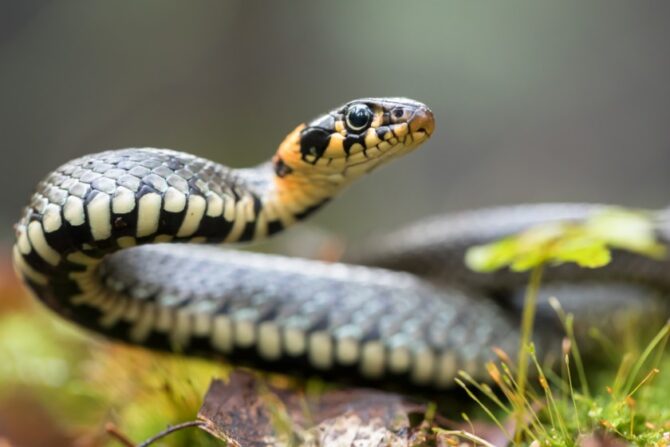
As we mentioned earlier, snakes are exclusively carnivores.
Currently, there isn’t a single known snake species that feeds on plants, even in the tiniest amount.
Therefore, there’s no such thing as an omnivorous or herbivorous snake, as the body system of a snake simply isn’t designed to digest plants.
Snakes have short digestive tracts and often eat by swallowing prey whole.
Their feeding pattern involves consuming a meal that can sustain them for days or even weeks.
Plants, unlike meat-based diets, simply do not contain enough calories to provide enough energy for snakes.
Besides, snakes lack the essential gut bacteria needed to break down a plant-based diet and get the most out of it.
For snakes, plants serve better as areas for camouflage and lying in ambush for prey rather than as meals.
So, in the absence of plants, what exactly do snakes eat?
What Do Snakes Eat?
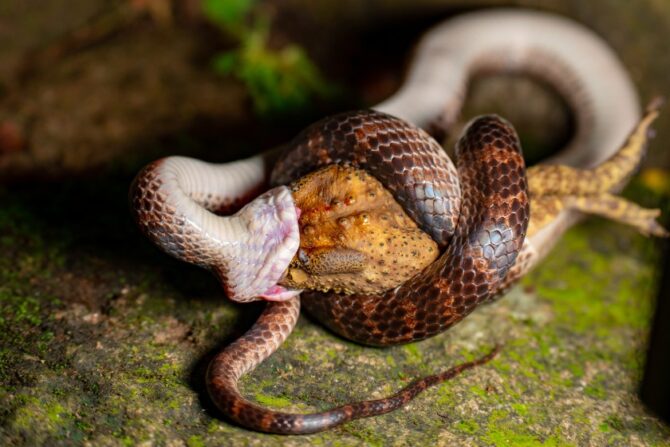
Snakes come in various sizes, from tiny snakes like thread snakes to massive snakes like pythons and anacondas.
Their sizes play a major role in their choice of food.
Small snakes usually feed on smaller animals, as their small body can only accommodate small prey.
They usually prey on animals like fish, frogs, birds, lizards, insects, rodents, and other small mammals.
However, larger snakes, like pythons, can go after larger prey.
They often target animals like pigs, deer, sheep, and even larger predators such as crocodiles and tigers.
Hunting these larger predators poses more challenges, so these snakes usually hunt them only when they are desperate or extremely hungry.
Interestingly, some snakes also include their kind on their menu.
Certain snake species, such as the California kingsnake and the king cobra,2 will go to extreme lengths to attack and eat other snakes.
In addition to these diverse food options, there are some snakes that eat only the eggs of birds and other animals.
How Do Snakes Hunt Their Prey?

For legless creatures, snakes sure are incredibly vicious hunters.
They have evolved over time, and so have their hunting strategies, as they usually take advantage of their surroundings and habitat to ensure a successful catch.
Certain snakes, like the puff adder, are excellent at camouflaging.
They lay in wait, blending in with their environment, until an unsuspecting prey falls into their trap.
Other snakes, like the cottonmouth, will lure prey with a false promise of a catch by strategically positioning the bright yellow end of their tail to look like worms.
Birds frequently fall into the cottonmouth trap.
Then, there are snakes, like the blue racer, which actively stalk their prey for hours, waiting for the perfect moment to strike.
When it comes to hunting, it all comes down to two methods: hunting as a venomous snake and hunting as a non-venomous snake.
Venomous snakes seldom get too physically involved in hunting their prey.
They rely on their venom to incapacitate their prey.
However, for their venom to work, they must strike their prey with their fangs and inject venom into its body.
This can be physically demanding, especially if the prey puts up a fight.
However, venomous snakes usually display some cunningness rather than getting physical to land that deadly bite.
Once the prey is bitten, it becomes paralyzed, and the snake can swallow it whole.
The venom of some snakes contains hemotoxins that destroy the cells and tissues in their prey and aid easy digestion.
Non-venomous snakes, on the other hand, follow a more physical approach.
They are constrictors, so they kill their prey by coiling their bodies tightly around their prey and squeezing the life out of it.
Some overpower their prey and swallow them alive.
Snakes have incredible sensory skills to aid their hunting.
They use their forked tongue to detect prey, collect sensory information, and track it over long distances.3
Some snakes, like the rattlesnake, can sense the heat emitted by potential prey or predators within their vicinity.
This heat-sensing ability not only helps in hunting but also serves as a defense mechanism.
How Much Do Snakes Eat?
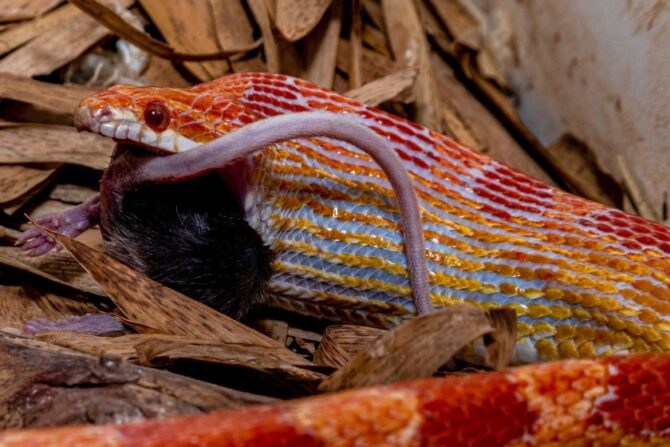
Snakes are cold-blooded reptiles, so they don’t eat much, regardless of their size.
In fact, deers eat much more food than snakes.
Unlike mammals, which must eat frequently to generate energy and maintain body temperature, snakes only use about 10 percent of the energy gained from food and thus eat less.
They get their heat from the sun’s energy rather than their body generating heat.4
In addition to their lower food intake, snakes also drink less water.
When it comes to eating, they do not chew their food despite having sharp teeth.
Instead, they prefer to swallow it whole.
Their teeth are used for capturing and securing prey, as well as defending themselves against predators.
At this point, you may be wondering, How do snakes manage to swallow large meals without chewing?
Well, snakes have very flexible jaws that can open up wide to accommodate prey with a diameter larger than their head.5
Their bodies are equipped with powerful muscles that help them move efficiently on the ground and aid in the process of moving food down their bowel.
When consuming especially big-sized meals, a snake may spend several hours completing the swallowing process.
After ingestion, complete digestion can take anywhere from a few days to weeks and, sometimes, even months.
This prolonged digestion process is one factor that influences snakes’ occasional feeding habits.
After digestion, snakes will vomit undigested parts such as hooves, bones, or horns.
Frequently Asked Questions
What Is Snakes’ Favorite Food?
Based on their general diet, snakes’ favorite meals are warm-blooded animals.
What Do Snakes Like to Drink?
Snakes drink mist from their scales and droplets of rainwater.
Some snakes live most of their lives in the oceans, so they drink water just like any mammal would.
How Long Can a Snake Go without Eating?
Snakes can feed frequently or occasionally, depending on the availability of prey.
However, they can go for weeks or months without meals.
Generally, a snake can last two months without food.
How Long Can Snakes Last without Water?
Snakes can last between weeks and months without water.
However, this differs for snakes in captivity as they may not survive beyond a week without water.
What Food Is Poisonous to Snakes?
Certain insects are poisonous to reptiles.
For instance, the firefly has a defensive steroid known as lucibufagins that is unsafe for reptiles to eat.6
Wrapping Up
Snakes are carnivores, and if you’ve ever asked the question, “What do snakes eat?”—well, now you know the answer.
Snakes eat various meat-based diets ranging from insects to rodents, amphibians, and even other snakes.
While they can feed on large animals, they usually opt for smaller prey, as they are easier to catch.
No matter the food a snake chooses to eat, you can trust it will be a carnivore’s diet.
Their diet suits their nature as predators, and there is no reason to change.
Their exceptional hunting skills, among other traits, make these creatures formidable predators in the wild.
References & Notes
- List of snakes. Britannica
- Cannibal cobras: Male snakes eat each other shockingly often. National Geographic
- Why Snakes Have Forked Tongues. Science
- Sneaky Snake Facts 2 – how often do snakes eat? The University of Melbourne
- Prey Size – an overview. ScienceDirect
- Photinus – an overview. ScienceDirect
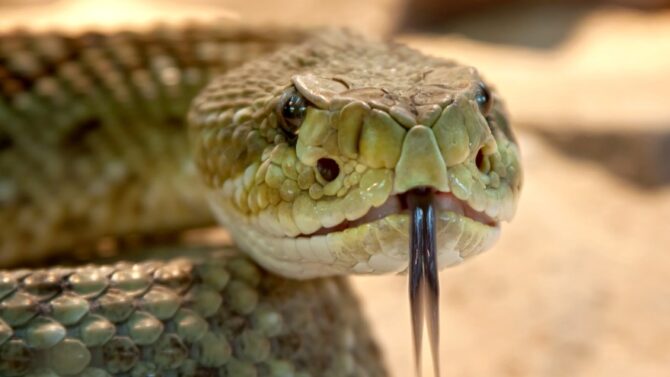

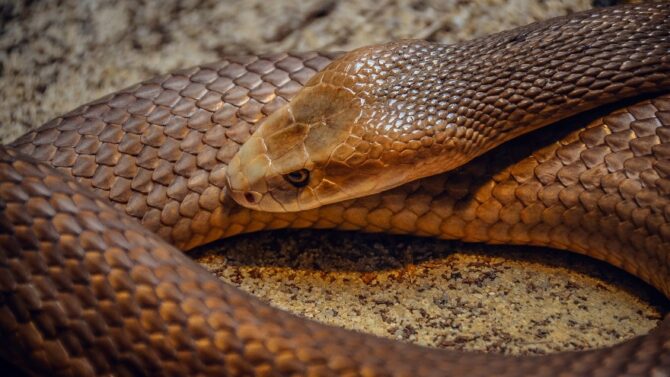
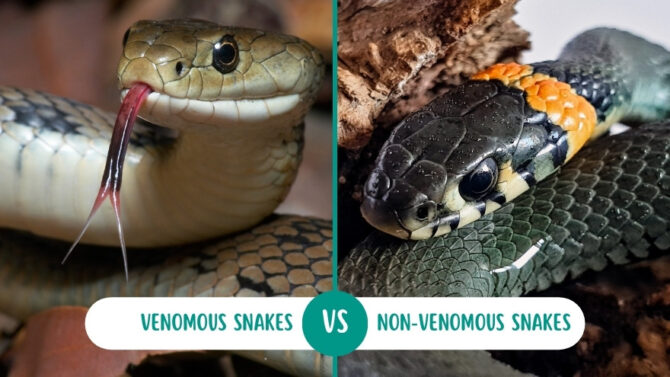


![How Often Do Corn Snakes Shed Their Skin [Answered]](https://animalvivid.com/wp-content/uploads/2022/11/How-Often-Do-Corn-Snakes-Shed-Their-Skin-Answered.jpg.webp)